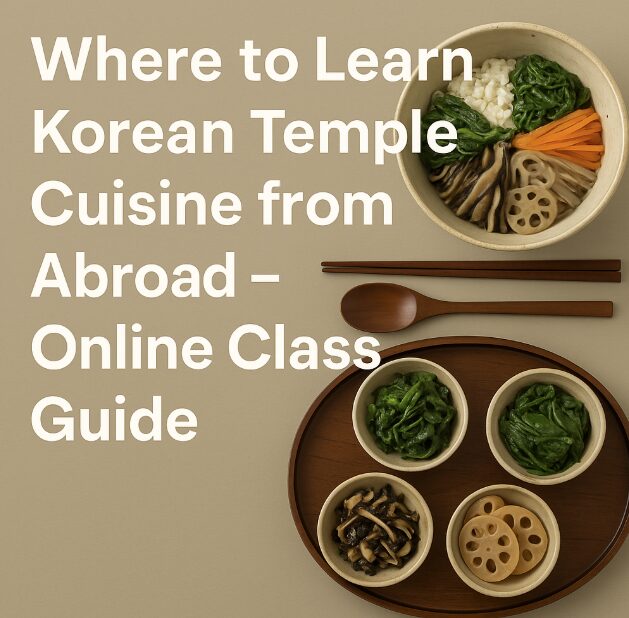If you’re interested in Korean culture, plant-based food, or mindfulness, Korean temple cuisine (사찰음식) is a rich, often overlooked tradition that brings all three together. Developed over centuries by Buddhist monks, Korean temple cuisine is more than just a diet — it’s a way of cooking and living that emphasizes harmony with nature, seasonal ingredients, and inner calm.
Unlike mainstream Korean food, temple cuisine is fully vegan, free from strong aromatics like garlic and onions, and deeply rooted in Buddhist principles. As interest in wellness, slow food, and mindful eating grows globally, more people — including chefs, home cooks, and spiritual seekers — are looking to learn Korean temple food from abroad.
In this post, we’ll guide you through the best online courses and virtual programs where you can learn Korean temple cuisine no matter where you are in the world. Whether you’re in the U.S., Europe, Southeast Asia, or elsewhere, these programs offer immersive access to Korea’s most meditative food tradition.

What Is Korean Temple Cuisine?
Temple cuisine is the traditional food prepared and consumed by Buddhist monks and nuns in Korean temples. It is:
100% plant-based (no meat, fish, eggs, or dairy)
Free from pungent vegetables (no garlic, onions, scallions, chives, or leeks)
Seasonal and local — using mountain herbs, fermented pastes, and wild greens
Rooted in Seon Buddhism (Zen), emphasizing mindfulness and gratitude
Prepared and eaten with respect for all living beings
Typical ingredients include tofu, perilla seeds, lotus root, kelp, mountain vegetables (namul), fermented soybean paste (doenjang), and rice-based dishes.
Learning temple food isn’t just about cooking — it’s about deepening awareness of your ingredients, your body, and the interconnectedness of all life.
Who Might Want to Learn Temple Food from Abroad?
Korean temple cuisine has attracted a diverse global audience:
Vegetarians and vegans seeking new cultural perspectives on plant-based cooking
Wellness and meditation practitioners exploring mindful eating
Chefs and culinary students interested in fermentation and heritage cooking
K-culture fans who want to experience deeper aspects of Korean tradition
Buddhists or spiritual seekers connecting to Korean Seon traditions
The good news? You don’t have to travel to a mountain temple in Korea to experience this cuisine firsthand.
Top Online Platforms to Learn Korean Temple Cuisine
Below are the best online classes and learning opportunities, whether you’re a beginner or already experienced in Asian vegetarian cooking.
1. Balwoo Gongyang – Official Temple Food Center
Website: https://eng.t templefood.kr
Run by the Korean Temple Food Center, this is the most authentic source for temple cuisine education outside of Korea’s temples themselves.
Key features:
Offers free and paid online workshops with English subtitles
Taught by Sunjae (monastic culinary masters)
Includes lessons on fermentation, seasonal side dishes, and Seon Buddhist philosophy
Downloadable recipes with detailed ingredient lists
Covers etiquette of mindful eating and cooking rituals
Highly recommended if you want to learn temple cuisine from its origin point.
2. YouTube Channels by Korean Buddhist Nuns
Some Buddhist nuns in Korea have embraced YouTube as a way to share temple food philosophy globally.
One notable channel:
“Jigme’s Temple Table” (지금의 사찰밥상)
Taught by a practicing nun in Korean temples
Subtitled in English, Japanese, and Chinese
Focuses on everyday temple cooking, using simple ingredients
Includes quiet, meditative cooking without narration
Search “Korean temple food” or “사찰음식 영어 자막” on YouTube for more channels.
3. Korean Cultural Centers Abroad
Many Korean Cultural Centers, run by Korea’s Ministry of Culture, offer seasonal online cooking classes that include temple cuisine.
Examples:
KCC New York, KCC London, KCC Jakarta, and KCC Paris
Programs are usually free and include a downloadable recipe PDF
Some events are live-streamed with Q&A sessions and chef interviews
Sessions often coincide with Korean holidays like Buddha’s Birthday (부처님 오신 날)
Check your local KCC’s official website or social media page for event schedules.
4. Temple Stay Online Workshops
Some Korean Buddhist temples that offer Temple Stay programs now run online workshops for international participants.
Temples like Jogyesa, Geumsunsa, and Baekyangsa (home of Jeong Kwan) occasionally host virtual cooking demonstrations or pre-recorded classes, which include:
Ingredient overviews
Guided meditation before cooking
Cooking demos of temple kimchi, rice cakes, or herbal teas
Discussion on Buddhist values of food preparation
Note: These events are limited and often require early registration.
5. Coursera and Udemy (Temple Food-Adjacent Learning)
While not dedicated to temple food, some cooking and wellness instructors include Korean temple-style recipes in their courses on:
Korean vegetarian cooking
Fermented foods of East Asia
Mindful eating and spiritual nutrition
Search terms to try:
“Korean vegan cooking”
“Temple cuisine”
“East Asian plant-based food”
“Fermented Korean recipes”
These platforms can be a good supplement to more traditional sources.
Where to Find Temple Food Ingredients Abroad
Once you start learning, you may want to recreate dishes at home. Common ingredients include:
Doenjang (fermented soybean paste)
Bokbunja (Korean wild herbs)
Dried mushrooms, lotus root, kelp, perilla powder
Rice flour, jujube, pine nuts
Online retailers:
Or visit your local Korean or East Asian grocery store and look for products labeled “사찰용” (temple-use) or “무마늘무파” (no garlic, no onion).
Temple Food Isn’t Just a Diet — It’s a Philosophy You Can Live
Learning Korean temple cuisine is about more than recipes. It’s an entry point into a slower, more thoughtful way of living — one that values respect for nature, minimalism, and presence in every bite.
Thanks to online classes, YouTube, and cultural outreach programs, you can begin your journey into Korean temple food from anywhere in the world. Whether you’re a culinary explorer, a wellness enthusiast, or someone looking for spiritual depth through food, this tradition has something uniquely nourishing to offer — for both body and mind.